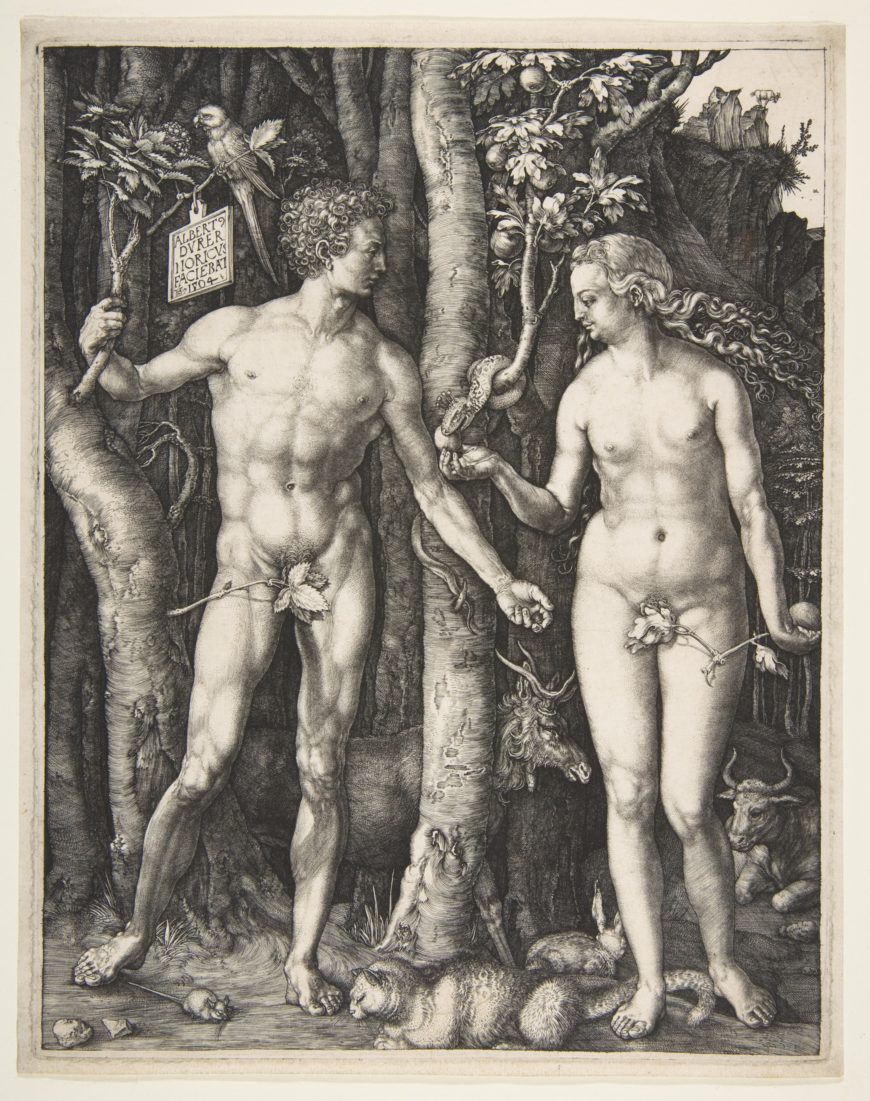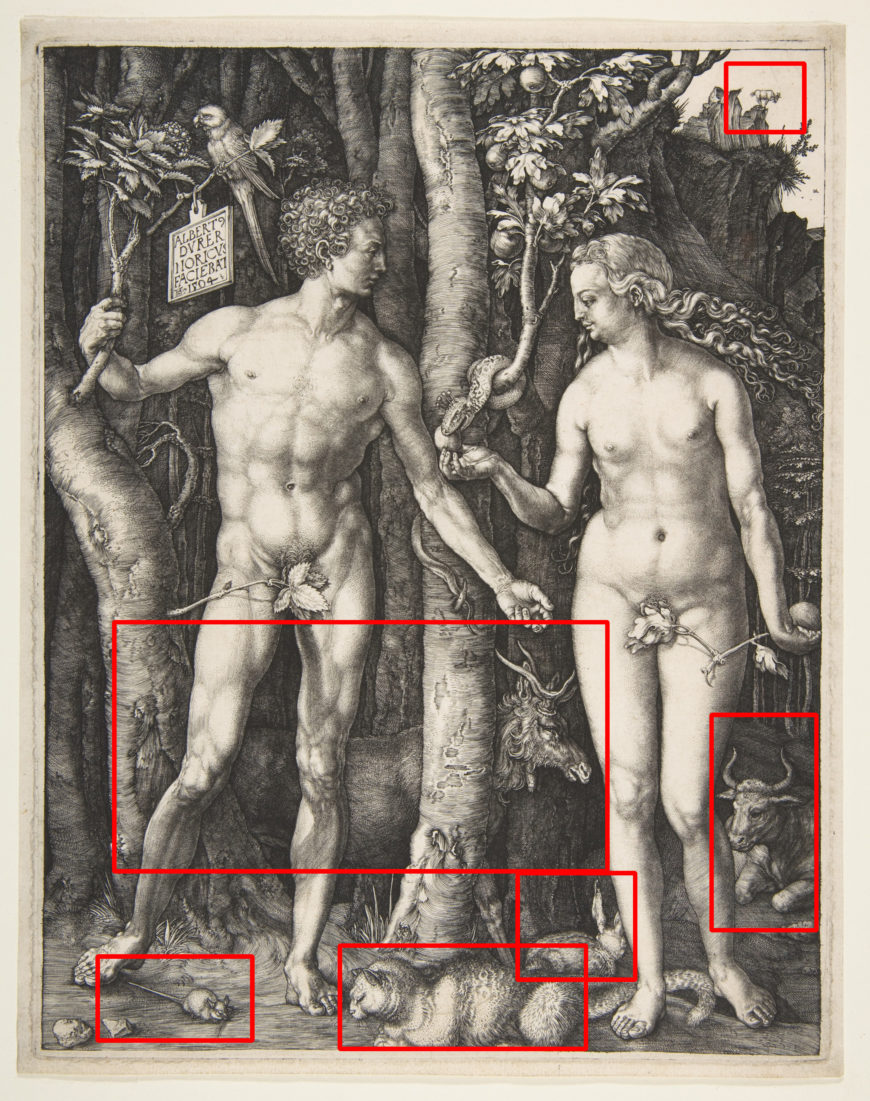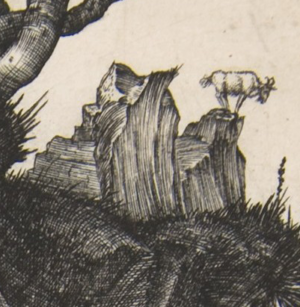Albrecht Dürer, Adam and Eve

Is there anything left to say about Adam and Eve, quite literally the oldest story in the book? The engraving of Adam and Eve of 1504 by the German renaissance artist Albrecht Dürer recasts this familiar story with nuances of meaning and artistic innovation. In the picture, Adam and Eve stand together in a dense, dark forest. Far from the garden evoked in Genesis, this forest is distinctly German, the dark woods of the devils and spooks of Grimm’s fairy tales. Foreign and unexpected motifs intrude into this German wood.
The figures

Despite the chill of the forest, the two human figures appear nude. Their bodies are frontal, and they stand in a classical contrapposto. Despite this apparent naturalism, their heads are turned to the side as they gaze at one another. This twisting configuration of head and body is distinctly artificial. The naturalizing contrapposto clashing with the artificiality of the rest of the pose establishes a pattern of contradictions that run throughout the picture. A seemingly astutely observed tree becomes distinctly odd, as we recognize that Eve is plucking an apple from a tree with fig leaves. A parrot, a tropical bird, perches on a branch to the viewer’s left. Six other animals stroll disinterestedly through or stand about—an elk, ox, cat, rabbit, mouse, and goat.

The cartelino or small sign hanging from a branch Adam grasps contains its own contradiction. It proudly identifies the artist as a citizen of the Franconian city of Nuremberg (Noricus), but does so in Latin, the language of the Mediterranean, of the Roman Empire and of the Italian Renaissance. How does this curious blend of motifs further the story of Adam and Eve?
The answer is that the picture tells us primarily about the Renaissance, about Germany, and about Dürer himself rather than the text of Genesis, from which it departs most strikingly. The poses of the two human figures are contrived to show off this German artist’s knowledge of classical (Greco-Roman) proportions. (Dürer had traveled to Italy in 1494 where he studied the works of Renaissance masters firsthand)

Symbols
Colorful, tropical parrots were collectors items in Germany, and they were also symbols in art. The call of the parrot was believed to sound like “Eva-Ave”—Eve and Ave Maria (“Hail Mary,” the name of a prayer in honor of the Virgin Mary). This word play underpins the Christian interpretation of the story of the Fall of Humanity by characterizing the Virgin Mary, mother of Christ, as the antidote for Eve’s sin in the Garden of Eden. The other animals bear other symbolic meanings. The elk, ox, rabbit, and cat exemplify the four humors or human personality types, all of which correlate with specific fluids in the body.

Melancholic: elk, black bile
Phlegmatic: ox, phlegm
Sanguine: rabbit, blood
Choleric: cat, yellow bile
Only Adam and Eve are in perfect balance internally. After the Fall, one humor predominates in everyone, throwing our temperaments into imbalance. Dürer’s placid animals signify that in this moment of perfection in the garden, the human figures are still in a state of equilibrium. The cat does not yet chase the mouse, and the goat (a reference to the scapegoat of the bible) is still standing on his mountain perch.
A German enthralled by the classical tradition
The print allows Dürer to express his personal and cultural concerns. Proud of his German identity (Albert Dvrer Noricvs or “Albert Dürer of Nuremberg”), the artist is nonetheless enthralled by Italian and classical tradition. The German forest is ennobled by classically proportioned figures who actually reference Greek sculptures of Venus and Apollo, and anchored in tradition with the symbolism of the humors. In Renaissance fashion, the perfect physical proportions of the body correlate with the interior harmony of the humors.
Mechanical reproduction
Pictures made in multiples, such as the Adam and Eve engraving, meant that the ideas and designs of a German artist could be known in other regions and countries by large numbers of people. German artists could learn about classical art without traveling to Italy. More kinds of people could afford more pictures, because prints are easier to produce and typically less expensive than paintings. The traditional, direct contract between artist and patron, where one object was hand-produced for one patron and one place, gave way to a situation where multiple images could be seen by unknown viewers under an infinite variety of circumstances.
Dürer was to master painting and surpass all others in printmaking, both relief and intaglio. Ultimately he would rely on his prints for profit and recognition. Dürer not only experienced the transformation from Gothic to Renaissance, he was an agent of that change.[1]
- Dr. Bonnie Noble, "Albrecht Dürer, Adam and Eve," in Smarthistory, August 9, 2015, accessed March 31, 2023, https://smarthistory.org/durer-adam-and-eve/ ↵

